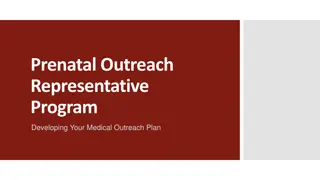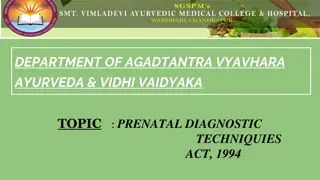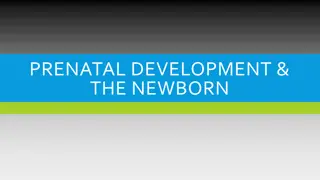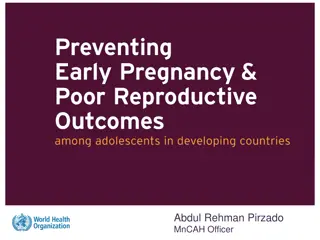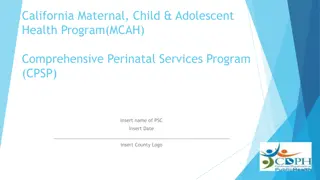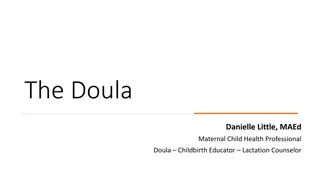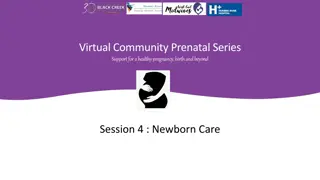Importance of Prenatal Care for Expectant Mothers
Prenatal care plays a crucial role in reducing the risks associated with pregnancy, such as pre-term birth and mortality rates. It involves establishing baseline data, monitoring weight and physical changes, and confirming pregnancies through tests. The goals of prenatal care include promoting the health of the mother, fetus, and newborn, ensuring a safe birth, teaching post-pregnancy health habits, and preparing parents for parenthood responsibilities. Regular prenatal visits help in screening for disorders, reducing risks, and providing counseling to expectant mothers for a healthy pregnancy and delivery.
Download Presentation

Please find below an Image/Link to download the presentation.
The content on the website is provided AS IS for your information and personal use only. It may not be sold, licensed, or shared on other websites without obtaining consent from the author. Download presentation by click this link. If you encounter any issues during the download, it is possible that the publisher has removed the file from their server.
E N D
Presentation Transcript
Why prenatal care is important Can decrease risk of pre-term babies or abortions Can decrease mortality rates ( ectopic pregnancy, hypertension, embolism, infection, hemorrhage are the main causes of death during pregnancy) The first prenatal visit Establish a baseline data. Explain why specific data are related to pregnancy Discuss weight changes and physical changes during pregnancy Urine analysis Establish communication in a private, quite setting Confirm pregnancy: assess for signs of pregnancy
Goals of prenatal care Promote the health of the mother, fetus, newborn, and family. Ensure a safe birth for mother and child by promoting good health habits and reducing risk factors. Teach health habits that may be continued after pregnancy.(diet,hygein) Provide physical care. Encourage breast feeding Prepare parents for the responsibilities of parenthood
Chief Concern Get information to confirm pregnancy: date of the last menstrual period, had a pregnancy test. Find the expected date of delivery as follows: 1st day of LMP + 7 days 3 months + 1 year. (4,------12month) 1st day of LMP +7 days 1st day of LMP + 7 days +9months + same year (1,2,3,month)
Prenatal care: The initial routine prenatal visit should occur between 6 and 8 weeks gestation. Follow-up visits should occur at About 4-week intervals until 28 weeks 2-week intervals from 28 to 36 weeks Weekly thereafter until delivery Prenatal visits may be scheduled more frequently if risk of a poor pregnancy outcome is high or less frequently if risk is very low. Prenatal care includes Screening for disorders Taking measures to reduce fetal and maternal risks Counseling
information about signs of early pregnancy such as nausea, vomiting, breast changes or fatigue. Ask about danger signs of pregnancy such as bleeding, continuous headache, visual disturbances, or swelling of the hands and face. Ask if the pregnancy was planned.
CLINICAL CALCULATOR: Pregnancy Gestation by LMP and Ultrasound Biometry History During the initial visit, clinicians should obtain a full medical history, including Previous and current disorders Drug use (therapeutic, social, and illicit) Risk factors for complications of pregnancy . Obstetric history, with the outcome of all previous pregnancies, including complications (eg, gestational diabetes, preeclampsia, congenital malformations, stillbirth) maternal and fetal Family history should include all chronic disorders in family members to identify possible hereditary disorders .
3- History of the Past Illness Ask about diseases that can pose potential difficulty during pregnancy such as kidney diseases, heart diseases, rheumatic fever, sexually transmitted disease, diabetes, or asthma. Ask about any allergies, Ask bout any past surgical procedure
Gravidity and parity Gravidity is the number of confirmed pregnancies; a pregnant woman is a gravida. Parity is the number of deliveries after 20 weeks. Multifetal pregnancy is counted as one in terms of gravidity and parity. Abortus is the number of pregnancy losses (abortions) before 20 weeks regardless of cause (eg, spontaneous, therapeutic, or elective abortion; ectopic pregnancy). Sum of parity and abortus equals gravidity.
Parity is often recorded as 4 numbers: Number of term deliveries (after 37 weeks) Number of premature deliveries (> 20 and < 37 weeks) Number of abortions Number of living children Thus, a woman who is pregnant and has had one term delivery, one set of twins born at 32 weeks, and 2 abortions is gravida 5, para 1-1-2-3
4- History of Family Illness Ask about illness that occur frequently in the family and cause potential problems in the pregnant woman or in the infant after birth, like any inherited diseases or congenital anomalies
7- Obstetric History Review the previous pregnancy briefly. previous miscarriages or abortion blood type Rh negative, ask if she received Rh immune globulin (RhIG) after abortions or previous births.
Ask if she has ever had a blood transfusion. Determine number of times she has been pregnant, including the present pregnancy (Gravida). Determine number of children above the age of viability she has previously borne (Para).
Examples: A woman who had two previous pregnancies, has given birth to two term children and is again pregnant: She is gravida 3, para 2
Examples: A woman who had two previous pregnancies, has given birth to two term children and is again pregnant: She is gravida 3, para 2
(GTPAL or GTPALM) provide greater detail on a woman s history. By this system the gravida classification remains the same, but para is broken down as follows: G: Gravida T: the number of full- term infants born (born at 37 weeks or after). P: the number of preterm infants born(borne before 37 weeks). A: the number of spontaneous or induced abortions. L: The number of living children. M: Multiple pregnancies
Examples: A woman who had two previous pregnancies, has given birth to two term children and is again pregnant: gravida 3 para 2002 (GTPAL) or 320020 (GTPALM)
A woman who has had two abortions at 12 weeks (under age of viability) and is again pregnant. Gravida 3 para 0020 (GTPAL) or 300200 (GTPALM) A woman who had term twins, then one preterm infant, and is now pregnant again. Gravida 3, para 21031 (A multigestation pregnancy
. A pregnant woman who had the following past history: a boy born at 39 week s gestation, now alive and well; a girl born at 40 week s gestation, now alive and well; a girl born at 33 week s gestation, now alive and well. 421030 (GTPALM)
Physical Examination A full general examination, including blood pressure (BP), height, and weight, is done first. Body mass index (BMI) should be calculated and recorded. BP and weight should be measured at each prenatal visit. In the initial obstetric examination, speculum and bimanual pelvic examination is done for the following reasons: To check for lesions or discharge To note the color and consistency of the cervix To obtain cervical samples for testing Also, fetal heart rate and, in patients presenting later in pregnancy, lie of the fetus are assessed .
Pelvic capacity can be estimated clinically by evaluating various measurements with the middle finger during bimanual examination. If the distance from the underside of the pubic symphysis to the sacral promontory is > 11.5 cm, the pelvic inlet is almost certainly adequate. Normally, distance between the ischial spines is 9 cm, length of the sacrospinous ligaments is 4 to 5 cm, and the subpubic arch is 90 . During subsequent visits, BP and weight assessment is important.
*Obstetric examination focuses on uterine size, fundal height (in cm above the symphysis pubis), A.fetal heart rate and activity, B.and maternal diet, weight gain, C.and overall well-being. Speculum examination is usually not needed unless vaginal bleeding, leakage of fluid, or pain is present. and bimanual discharge or
Important note: if a woman voids for clean-catch urine before the exam, this can: Reduce bladder size and make the pelvic examination more comfortable. Provide a urine specimen for laboratory testing.
1- Baseline Height/ weight and vital sign Measurement Overweight (More than 20 kg above the weight-height baseline) leads to an increased risk of gestational diabetes, pregnancy- induced hypertension and thrombo-embolic disorders.
Underweight (less than 20kg below the weightheight baseline) also puts the pregnant woman at a great risk. Vital signs including blood pressure, respiratory rate, and pulse rate, are measured.
Assessment of the Systems General Appearance and Mental Status Head and Scalp. Face Eyes. Nose. The increase level of estrogen may cause nasal congestion or the appearance of swollen nasal membranes Ears.. Mouth, teeth, and throat.. Neck. Observe for enlarged thyroid gland and scars of previous operations
Breasts. They should gently palpate to feel any lump. The nipples should be drawn forward to see they are protractile. The breasts should be observed for pregnancy changes. Heart. Heart rate ranges from 70 to 80 beats per minute. Many women notice occasional palpitations during pregnancy. Teach them to rest or sleep on their side (left side is best) to help avoid this problem.
Lungs. Vital capacity of the lungs is not reduced. However, late in pregnancy, the diaphragm movement is lessened because the diaphragm can not descend fully as usual due to distended uterus. Back. The lumbar curve in many pregnant women is increased on standing to maintain body posture. This response may cause backache.
Rectum. Assess it closely for hemorrhoid tissue, which commonly occurs from uterine pressure on pelvic veins preventing venous return
Extremities and skin. Assess the lower extremities carefully for varicosities which could be predisposing to deep vein thrombosis. Legs should be noted for edema. Any edema more than ankle swelling may be a danger sign of pregnancy. The calf must be observed for reddened areas which may be caused by phlebitis and white areas which could be caused by deep vein thrombosis. Ask the women to report tenderness during examination.
3- Abdominal Examination A. Inspection: the nurse should look at the following: Skin changes such as linea nigra, striae gravidarum and scars of previous operations.
The shape of the abdomen is inspected for: Fetal lie and position. The abdomen looks longer if the fetal lie is longitudinal as occurs in 99.5% of cases. The abdomen looks lower and broad if the fetal lie is transverse
Contour of the abdominal wall is observed for pendulous abdomen, lightening, protrusion of the umbilicus Fetal movements are inspected as evidence of fetal life and position. The abdomen also inspected for edema.
B. Palpation: Abdominal palpation includes: Measuring the fundal height to estimate the period of gestation: - After 12th week s gestation, the uterus is palpable over the symphysis pubis as a firm globular sphere. It reaches the umbilicus at 20 to 22 weeks and the xiphoid at 36 weeks, and then returns to about 4 cm. below the xiphoid due to lightening at 40 weeks
The fundal height may be higher than the expected due to Large size fetus, multiple pregnancy, polyhydrammnios, or mistaken date of last menstrual period. - The fundal height may be lower than the expected due to a small size uterus, intrauterine growth retardation, oligohydramnios or mistaken date of last menstrual period.
Diagnosing the fetal lie and presentation to determine whether the fetus in a vertex or breach presentation. Determining whether the head engagement has occurred or it is still floating.
C. Auscultation Fetal heart sound is heard by sonicaid (Doppler technique) as early as 10th -12th week of Pregnancy. Fetal heart sound is heard by Pinard s stethoscope The normal heart rate is 120-160 beats/ minute. Any deviation is considered one of fetal distress signs
- Pelvic Examination A pelvic examination reveals information on the health of both internal and external reproductive organs. External Genitalia. Any signs of inflammation, irritation, or infection, such as redness, ulcerations, or vaginal discharge are noted
Internal Genitalia. This includes: Cervix inspection. To view the cervix, the vagina must be opened with a speculum. The cervix can be inspected for: Position. Normally it is centered on the vagina; a retroverted uterus has a cervix positioned anteriorly, and an anteverted uterus has its cervix positioned posteriorly. Color. A nonpregnant cervix is light pink; in pregnancy it changes to almost purple.
Appearance. In the nulligravida, the cervical os is round and small, while in paras women, the cervical os has a slit( star)like appearance. Abnormal appearance. Carcinoma of the cervix appears as an irregular, granular growth at the os.
Pap Smear is taken for early detection of cervical cancer and diagnosis of precancerous conditions; it also reveals inflammatory and infectious diseases.
5- Estimating Pelvic Size This estimation is performed if the pregnant woman has never given birth vaginally before. Estimation may be made by a combination of pelvic pelvimetry and fetal sonography. It gives the actual diameters of the inlet 12cm and outlet through which the fetus must pass.
- Laboratory Assessment Blood studies: complete blood picture (Hb has to be repeated at the 36 weeks of pregnancy, and every 4 weeks if Hb is > 9g/dl). Screening for sickle cell anemia and thalassemia. A serologic test for syphilis (VDRL) Blood typing including Rh factor every visit
An indirect Coombs test for determination if Rh antibodies are present in an Rh negative woman Urinalysis: It is performed to test for protienuria, glycosuria,. All can be done by strips and microscopic examination of the urine
Ultrasonography: It is performed when the last menstrual period is unknown, and to assess the fetal growth and wellbeing.( uss end of pregnancy 3 rd ) End of 16th Week Sex can be determined by ultrasound End 12 Week Sex is distinguishable by outward appearance.
Review danger signs of pregnancy: Vaginal bleeding. Persistent vomiting. Chills and fever. Sudden escape of clear fluid from the vagina. Abdominal or chest pain( embolism)
sings of pregnancy-induced hypertension (PIH). * Rapid weight gain * Swelling of the face or fingers * Flashes of light or dots before the eyes. * Dimness or blurring of vision. * Severe, continuous headache * Decreased urine output. * Increase or decrease in fetal movement.
B- Physical Examination Blood pressure (every visit) Clean-catch urine for glucose, protein, and leukocytes (every visit) Blood serum level for alpha-fetoprotien ) (16 weeks) VDRL test for syphilis if possibility of new exposure. Glucose screen (28 weeks) Glucose challenge (24 to 28 weeks) if warranted Anti-Rh titer (28 weeks)
2. Fetal Health Fetal heart rate Fundal height Quickening or fetal movement Ultrasound dating of pregnancy Promoting health during pregnancy which include: self-care are required: Bathing. During pregnancy, sweating tends to increase because a woman excretes waste products for herself and a fetus. She also has an increase in vaginal discharge. For these reasons,
* Breast care. - A pregnant woman has to wear a firm, supportive bra with wide straps to spread weight across the shoulders. - At about 16th week of pregnancy, colostrums secretion begins in the breasts. Instruct her to wash her breasts with clear tap water (no soap, because that could be drying) daily to remove the colostrums and reduce the risk of infection. Afterward, she should dry her nipples well by patting them. Otherwise, constant moisture can cause nipple, pain, and fissuring.





